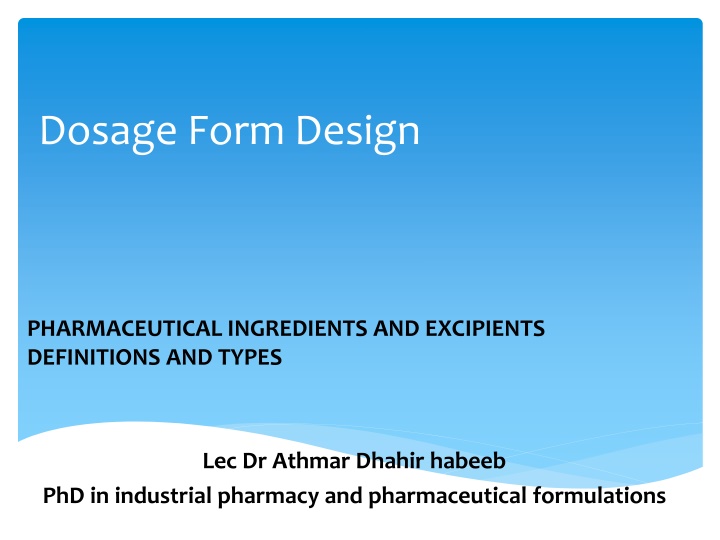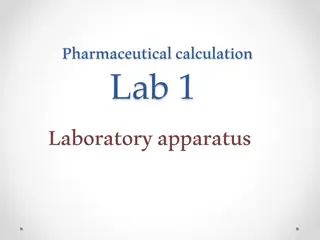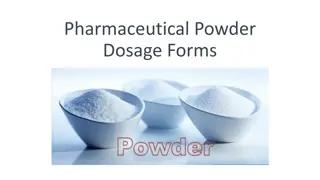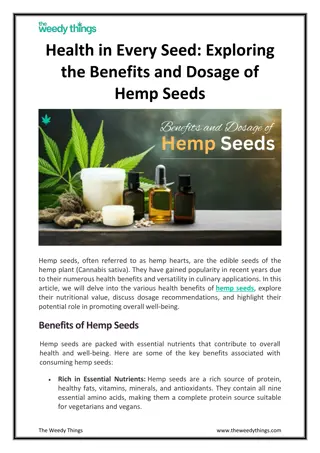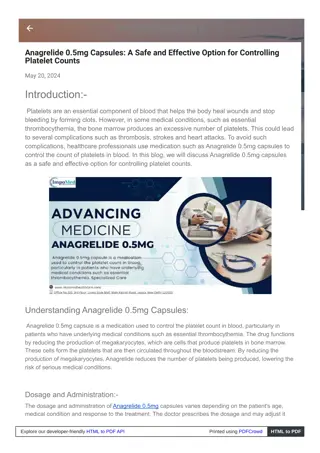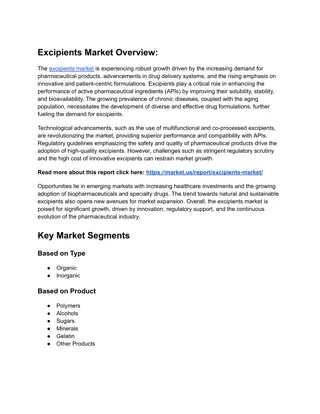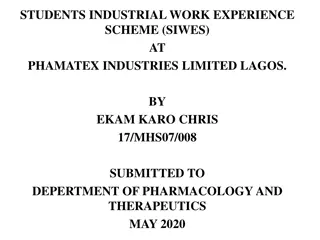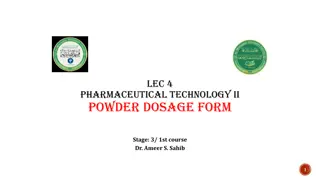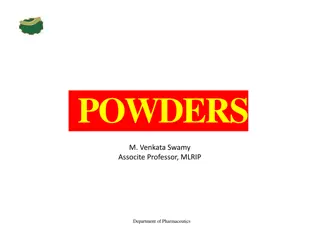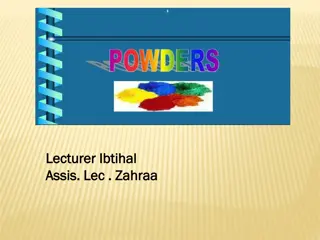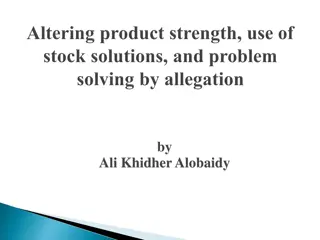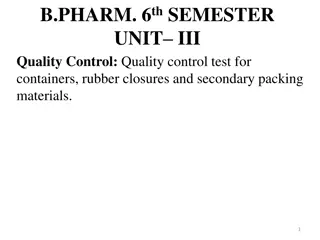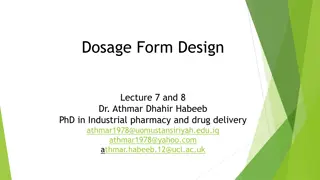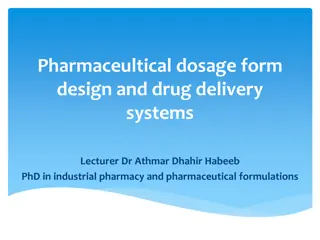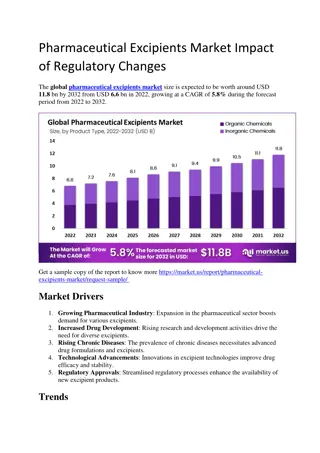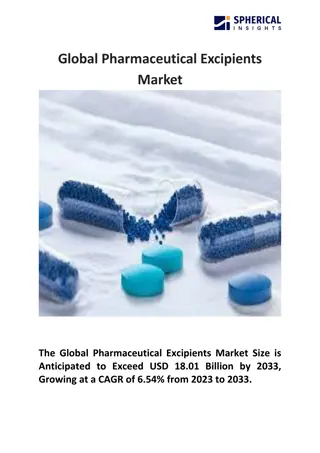Pharmaceutical Ingredients and Excipients in Dosage Form Design
Producing drug substances in their final dosage forms involves various pharmaceutical ingredients like solvents, flavors, colorants, preservatives, and stabilizers. Different dosage forms such as tablets, ointments, creams, and suppositories require specific excipients for formulation. The appearance and palatability of drug substances are crucial factors, with flavoring playing a significant role in enhancing palatability, especially in liquids intended for oral administration. Understanding taste sensation in drugs can be complex, with certain chemical compositions affecting taste perception. The use of excipients and flavoring agents is essential in pharmaceutical formulation development.
Download Presentation

Please find below an Image/Link to download the presentation.
The content on the website is provided AS IS for your information and personal use only. It may not be sold, licensed, or shared on other websites without obtaining consent from the author.If you encounter any issues during the download, it is possible that the publisher has removed the file from their server.
You are allowed to download the files provided on this website for personal or commercial use, subject to the condition that they are used lawfully. All files are the property of their respective owners.
The content on the website is provided AS IS for your information and personal use only. It may not be sold, licensed, or shared on other websites without obtaining consent from the author.
E N D
Presentation Transcript
Dosage Form Design PHARMACEUTICAL INGREDIENTS AND EXCIPIENTS DEFINITIONS AND TYPES Lec Dr Athmar Dhahir habeeb PhD in industrial pharmacy and pharmaceutical formulations
To produce a drug substance in a final dosage form requires pharmaceutical ingredients. For example, solutions 1. Solvents 2. flavors and sweeteners 3. colorants 4. preservatives 5. stabilizers Tablets, 1. 2. 3. 4. 5. diluents or fillers binders antiadherents or lubricants disintegrating agents coatings.
Ointments, characteristic features from their pharmaceutical bases. creams, and suppositories acquire their HANDBOOK OF PHARMACEUTICAL EXCIPIENTS AND FOOD AND CHEMICALS CODEX The Handbook of Pharmaceutical monographs on more than 250 excipients used in dosage form preparation. Additional excipients commonly used are listed in the Food Chemicals Codex (FCC), now owned and published by the USP. Excipients presents
APPEARANCE AND PALATABILITY Most drug substances in use today are unpalatable and unattractive in their natural state An electronic tongue is used to aid in providing a global taste fingerprint during formulation development.
Flavoring Pharmaceuticals The flavoring of pharmaceuticals applies primarily to liquids intended for oral administration. Why mostly liquids chewable tablets Selection of flavours and colours In flavor-formulating a pharmaceutical product, the pharmacist must give consideration to the color, odor, texture, and taste of the preparation.
There are no rules for accurately predicting the taste sensation of a drug based on its chemical constitution, However .. The salt taste is a function of both cation and anion. 1. Chlorides of sodium, potassium, and ammonium and by sodium bromide, NaCl, KCl, NH4Cl, NaBr 2. bromides of potassium and ammonium KBr, NH4Br 3. potassium iodide KI, magnesium sulfate MgSO4 (Epsom salt) .
With organic compounds, an increase in the number of hydroxyl groups ( OH) seems to increase the sweetness of the compound. Sucrose is sweeter than glycerin. organic esters, alcohols, and aldehydes Many nitrogen-containing compounds, especially the plant alkaloids (e.g., quinine) are extremely bitter, but certain other nitrogen- containingcompounds (e.g., aspartame) are extremely sweet. The medicinal chemist recognizes thateven the most simple structural change in an organic compound can alter its taste. 1. D-Glucose and L-glucose 2. saccharin and N-methyl- saccharin
The selection of an appropriate flavoring agent depends on several factors, primarily 1. The taste of the drug substance itself. cocoa flavored vehicles Fruit or citrus flavors cinnamon, orange, raspberry, and other flavors 2. The age of the intended patient Children adults
Flavors can consist of oil- or water-soluble liquids and dry powders; most are diluted in carriers. Oil-soluble carriers water-soluble carriers Dry carriers Flavors can degrade (check for stability) The different types of flavors include natural, artificial, and spice: A general guide to using flavors Water-soluble flavors Generally start at 0.2% for artificial and 1% 2% for natural flavors. Oil-soluble flavors Generally start at 0.1% in finished product for artificialflavors and 0.2% for natural flavors. Powdered flavors Generally start at 0.1% in finished product for artificialflavors and 0.75% for natural flavors.
Sweetening Pharmaceuticals In addition to sucrose, a number of artificial sweetening agents have been used in foods and pharmaceuticals over the years. Some of these, including aspartame, saccharin, and cyclamate, have faced challenges over their safety by the FDA and restrictions to their use and sale; 1969 Critical to the evaluation of food additives are issues of metabolism and toxicity.
saccharin is excreted by the kidneys virtually unchanged. Cyclamate is metabolized Aspartame breaks down in the body into three basic components: the amino acids phenylalanine and aspartic acid, and methanol. the use of aspartame by persons with phenyl ketonuria (PKU) is discouraged Acesulfame potassium, a nonnutritive sweetener discovered in 1967, was approved in 1992 by the FDA. Table 4.4 compares three of the mostcommonly use sweeteners in the food and drug industry: sucrose, saccharin and aspartame
A relatively new sweetening agent in U.S. commerce is Stevia powder, the extract from theleaves of the plant Stevia rebaudiana bertoni. It is natural, nontoxic, safe, and about 30 times as sweet as cane sugar, or sucrose. It can be used in both hot and cold preparations.
Coloring Pharmaceuticals Coloring agents are used in pharmaceutical preparations for esthetics. Although most pharmaceutical colorants in use today are synthetic, a few are obtained from natural mineral and plant sources. For example, red ferric oxide is mixed in small proportions with zinc oxide powder to give calamine its characteristic pink color
Certified color additives are classified according to their approved use: (a) FD&C color additives (b) D&C color additives (c) external D&C color additives For color additives, the study protocols usually call for a 2- year study Five categories of evidence of carcinogenic activity are used in reporting observations: (a) clear evidence of carcinogenic activity (b) some evidence (c) equivocal evidence, (d) no evidence, (e) inadequate study,
The certification status of the colorants is continually Reviewed. These changes may be (a) the withdrawal of certification, (b) the transfer of a colorant from one certification category to another (c) the addition of new colors to the list. the amount of colorant generally added to liquid preparations ranges from 0.0005% to 0.001% depending upon the colorant and the depth of color desired. dyes generally are added to pharmaceutical preparations in the form of diluted solutions rather than as concentrated dry powders WHY
In addition to liquid dyes in the coloring of pharmaceuticals, lake pigments may also be used. colors by dispersion. An FD&C lake is a pigment consisting of a substratum of alumina hydrate on which the dye is adsorbed or precipitated. Having aluminum hydroxide as the substrate, the lakes are insoluble in nearly all solvents. FD&C lakes are subject to certification and must be made from certified dyes. Lakes do not have a specified dye content; they range from 10% to 40% pure dye. By their nature, lakes are suitable for coloring products in which the moisture levels are low.
Lakes in pharmaceuticals are commonly used in the form of fine dispersions or suspensions. The pigment particles may range in size from less than 1 m up to 30 m. The finer the particle, the less chance for color speckling in the finished product Capsules shell Powdered drugs dispensed as such or compressed into tablets Both dyes and lakes are used to color sugar coated tablets, film-coated tablets, direct compression tablets, pharmaceutical suspensions, and other dosage forms. Traditionally, sugar-coated tablets have been colored with syrup solutions containing varying amounts of the water- soluble dyes,
Usually, a water-soluble dye is also adequately soluble in commonly used pharmaceutical liquids like glycerin, alcohol, and glycol ethers. Oil-soluble dyes may also be soluble to some extent in these solvents and in liquid petrolatum (mineral oil), fatty acids, fixed oils, and waxes. Another important consideration when selecting a dye for use in a liquid pharmaceutical is the pH and pH stability of the preparation to be colored.
The dye also must be chemically stable must be protected from oxidizing agents, reducing agents (especially metals, including iron, aluminum, zinc, and tin), strong acids and alkalis, and excessive heating. Dyes must also be reasonably photostable; For solid dosage forms of photolabile drugs, a colored or opaque capsule shell may enhance the drug s stability by shielding out light rays.
PRESERVATIVES certain liquid and semisolid preparations must be preserved against microbial contamination. Although some types of pharmaceutical products, for example, ophthalmic and injectable preparations, are sterilized by physical methods (autoclaving for 20 minutes at 15 lb pressure and 121 C, dry heat at 180 C for 1 hour, or bacterial filtration) during manufacture, many of them also require an antimicrobial preservative to maintain their aseptic condition throughout storage and use
Other types of preparations that are not sterilized during their preparation but are particularly susceptible to microbial growth because of the nature of their ingredients are protected by the addition of an antimicrobial preservative. Certain hydroalcoholic and most alcoholic preparations may not require the addition of a chemical preservative 15% V/V alcohol will prevent microbial growth in acid media 18% V/V in alkaline media. Most alcohol-containing pharmaceuticals, are self-sterilizing and do not require additional preservation
Preservative Selection When experience or shelf storage experiments indicate that a preservative is required in a pharmaceutical preparation, its selection is based on many considerations, including some of the following: The preservative prevents the growth of the type of microorganisms considered the most likely contaminants of the preparation. The preservative is soluble enough in water toachieve adequate concentrations in the aqueous phase of a system with two or more phases. The proportion of preservative remaining undissociated at the pH of the preparation makes it capable of penetrating the microorganism and destroying its integrity.
The required concentration of the preservativedoes not affect the safety or comfort of the patient when the pharmaceutical preparation is administered by the usual or intended rout The preservative has adequate stability The preservative is completely compatible The preservative does not adversely affect the preparation s container or closure.
General Preservative Considerations Microorganisms include molds, yeasts, and bacteria, with bacteria generally favoring a slightly alkaline medium and the others an acid medium.
Incompatibility Many of the recognized incompatible combinations that inactivate the preservative contain macromolecules, including various cellulose derivatives, polyethylene glycols, and natural gums. These include tragacanth,
Mode of Action Preservatives interfere with microbial growth, multiplication, and metabolism through one or more of the following mechanisms: 1. Modification of cell membrane permeability and leakage of cell constituents (partial lysis). 2. Lysis and cytoplasmic leakage 3. Irreversible coagulation of cytoplasmic constituents (e.g., protein precipitation) 4. Inhibition of cellular metabolism, such as by interfering with enzyme systems or inhibition of cell wall synthesis 5. Oxidation of cellular constituents 6. Hydrolysis A few of the commonly used pharmaceutical preservatives and their probable modes of action are presented in Table 4.6.
Preservative Utilization Certain intravenous preparations given in large volumes as blood replenishers or as nutrients are not permitted to contain bacteriostatic additives, On the other hand, injectable preparations given in small volumes can be preserved with a suitable preservative without the danger of the patient receiving an excessive amount of the preservative.
The required proportionvaries with the pH, dissociation, and other factors already indicated as well with the presence of other formulative ingredients with inherent preservative capabilities. For each type of preparation to be preserved, the research pharmacist must consider the influence of the preservative on the comfort of the patient. For instance, a preservative in an ophthalmic preparation must have an extremely low degree of irritant qualities, which is characteristic of chlorobutanol, benzalkonium chloride, and phenylmercuric nitrate, frequently used in ophthalmic preparations.
